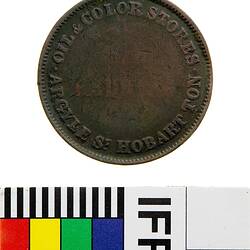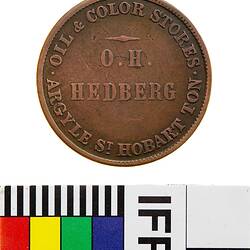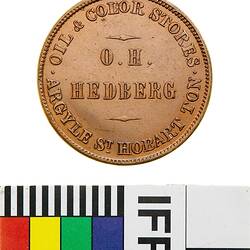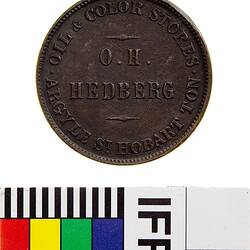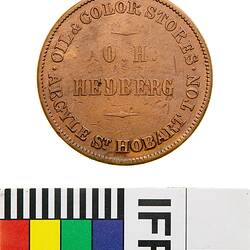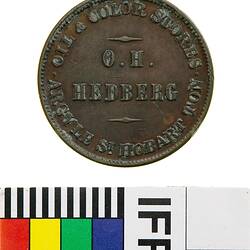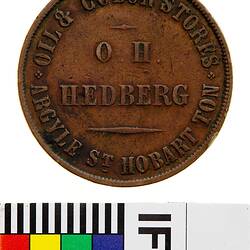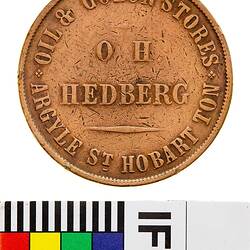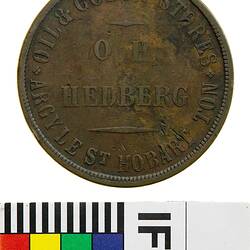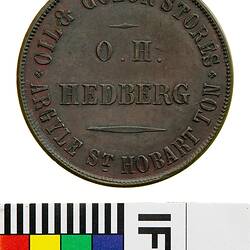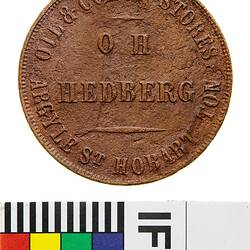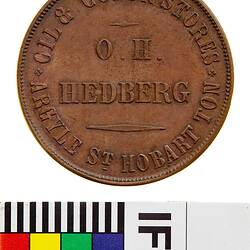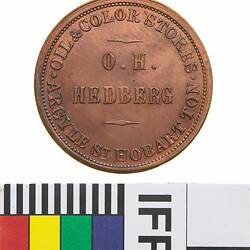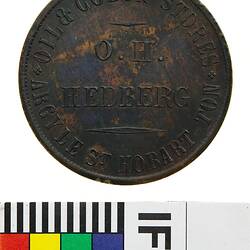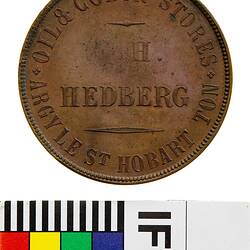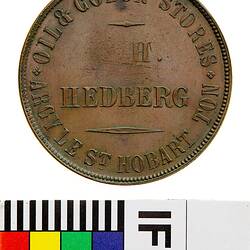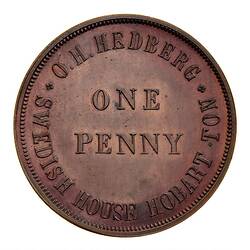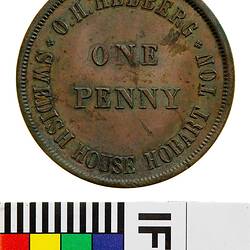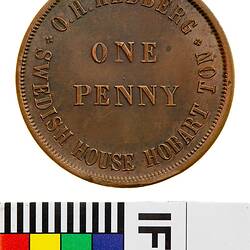Olof Hilmer Hedburg was born in the Swedish town of Uddevalla, on 14 April 1817. The first mention that numismatist Roger McNeice found of him in the public record was a listing as a small merchant in Sweden between 1835 and 1843. In 1838 he went to sea and eventually arrived in Hobart in 1844. He got work at the government's bonded store, through which he met Charles Seal. In 1850 Seal owned the largest fleet of ships in Tasmania, and it was through his backing that Hedberg was able to start his own business. In 1852, after Seal's death, Hedberg took over the running of his whaling business, which he later bought.
At this time Hobart was the base for the southern Ocean whaling fleet, which saw large numbers of ships using the port during the season. Hedberg himself owned two large whaling ships, the Victoria and the Maid of Erin. Whaling was a very profitable business for him until the mid-1850s, but then the price of whale oil, which had been as high as £83 per ton in the late 1840s, declined as did the number of whales being caught. Between the loss of income from whaling and the failure of a number of coal mines on the island's east coast, Hedberg was forced to turn to storekeeping and '.re-commenced business as produce merchant and commission agent in Argyle Street, Hobart. It was from this business that tokens were issued.' (McNeice, 1988 p.46). The following year he became a British subject. Hedberg was also active in Hobart's volunteer fire brigade, acting as volunteer superintendent for more than 13 years.
As well as his business and volunteer lives, Hedberg also had a family life. He married twice, first to Martha Williams, with whom he had eight children, and then after her death, Marian Wardlaw with whom he had another two. He died on 22 August 1884. McNeice cites the Tasmanian's account, which reported that all the ships in Hobart's harbour flew their flags at half mast on the 30th and 31st. (McNeice, 1988, p.47)
Hedberg advertised a range of products in Tasmanian publications. In early 1858 he advertised 'Sperm Oil, Black Oil, Colza Oil, Paint Oils, Turpentine' on the front page of the Hobart Mercury. In Walch's 1866 Tasmanian Almanac he took out a full page advertisement describing a wide range of paints, oils and varnishes.
Records from the Archives Office of Tasmania confirm the dates given by McNeice for Hedberg's birth, death, marriages, naturalisation and children.
His tokens were made by W.J. Taylor of London, although the later mules (tokens struck combining dies made for two separate issuers) are not necessarily Taylor's work. The Museum Victoria Catalogue dates the tokens to circa 1860.
References:
Andrews, A., Australasian Tokens and Coins, pp. 50-52.
McNeice, R., Tasmanian Coins and Tokens, 1803-1910, pp. 77-80.
Tasmanian Index to Applications for Naturalisation, <http://www.archives.tas.gov.au/genealres/naturalisation/h.htm>
Tasmanian Pioneer's Database, <http://resources.archives.tas.gov.au/Pioneers/taslink3.asp?ID=183948>
McNeice, R.V. (1988). 'Olof Hilmer Hedberg - Sailor, Emigrant, Whaler, Merchant and Fireman - Token issuer of Hobart Town' in The Journal of the Numismatic Association of Australia, Volume 4, March, pp. 45-48.
Advertisement, Hobart Mercury, 22 February 1858, p.1.
Advertisement, Walch's Tasmanian Almanac and Guide to Tasmania for 1866, p.81
More Information
-
Keywords
-
Localities
-
Authors
-
Article types



